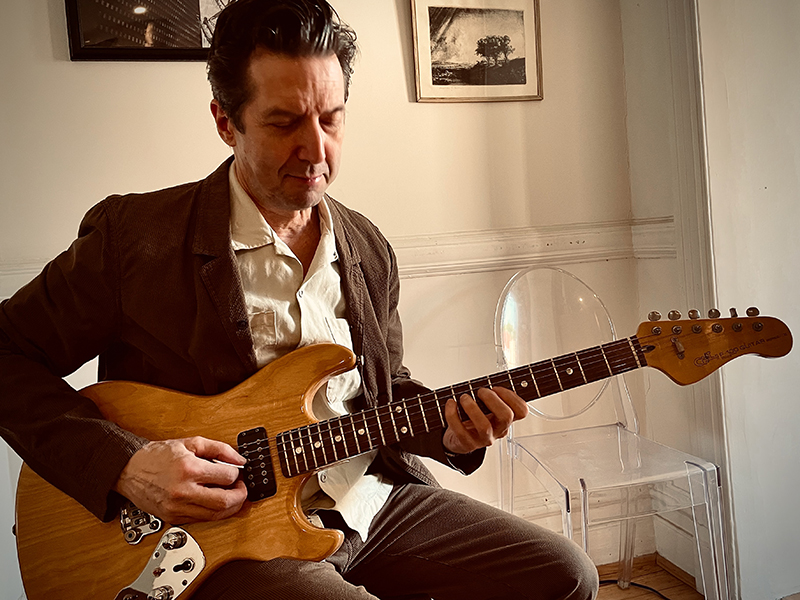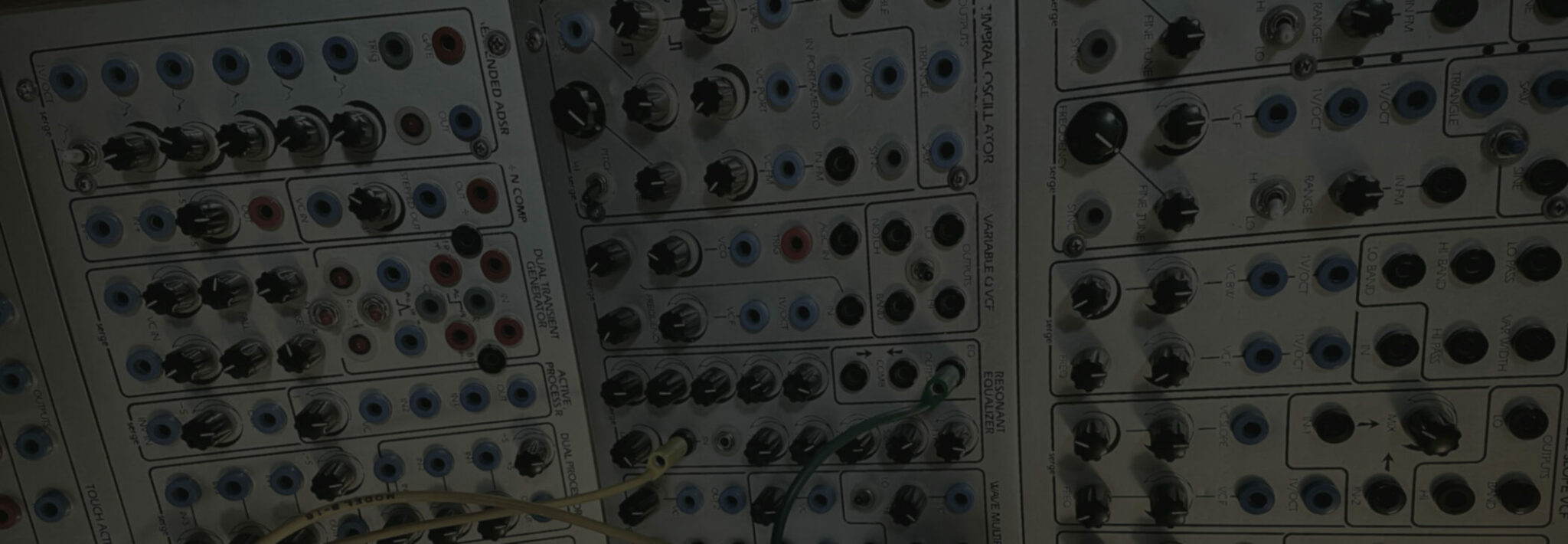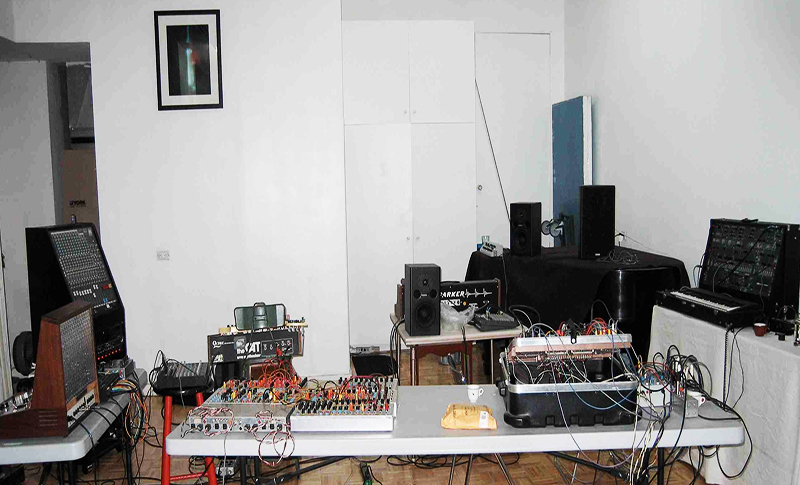
Michael J. Schumacher has composed more than 70 works for a variety of instruments and voices, and we are proud to present this Session focusing on his modular work.
Michael J. Schumacher is a composer, pianist, guitarist, improvisor and teacher based in Brooklyn, NY.
He’s worked with spatialized sound and algorithmic composition since the 1980s, creating multi-channel, generative “Room Pieces” presented in galleries, museums, concert halls, public and private spaces. He’s been a modular synth enthusiast since the 1970s, when he was introduced to the Buchla and other synthesizers at Studio PASS (now Harvestworks) in New York. Later, while studying at Juilliard, Hubert Howe gave him the key to the Queens College electronic studio, where he had access to a Buchla and a Moog modular.He generally uses synthesized sounds within compositions that are created using Max and other computer applications. His projects often expand the idea of the listening space, both architecturally and temporally: XI records has published a DVD set of five sound installations as computer applications, playable on up to eight speakers, which may be installed on a computer to create sound environments in the home. His building-wide installation at EMPAC, in Troy New York, ran 24/7 for one year. “Living Room Pieces” is a generative installation designed for home listening; in 2021 Schumacher made an edition of 10 for Raspberry Pi. “The Portable Multi-channel Sound System” is a complete immersive environment that fits in a suitcase, with which he has toured Europe and the United States.
His interest in the relationship of musical form and architecture led to the founding, with the generous support of Liz and Kirk Radke, of Diapason Sound Art, a gallery devoted to the presentation of multi-channel sound installations, long-duration performances and intermedia artworks. The gallery’s two high quality sound systems and its attention to the details of heightening aural perception made it an optimal space for creating and experiencing minimalist and process-based work. In its 15 years of existence Diapason and its predecessor Studio Five Beekman presented over 300 artists, including David Behrman, Olivia Block, Kabir Carter, Ronald Kuivila, Alan Licht, Alvin Lucier, Phil Niblock, Pauline Oliveros, Lee Ranaldo, Steve Roden, Janek Schaefer, Stephen Vitiello, Achim Wollscheid, and others.In the 1990s and 2000s Schumacher worked with La Monte Young and performed Young’s piano pieces, as well as those of Terry Jennings and others in the Dream House, both as soloist and with cellist Charles Curtis.
He also presented sound installations and concerts of his own electro-acoustic compositions in the Dream House.
Schumacher is the music director of the Liz Gerring Dance Company, with whom he has collaborated on a dozen evening-length works over the past 30 years. He also performs regularly with choreographer Sally Silvers.
As a guitarist he has recorded with The Donald Miller Trio and Dogbowl.
Between 2012 and 2018 he released three records with his band Dinmachine.He studied music composition with Stanley Applebaum, Bernhard Heiden, John Eaton and Vincent Persichetti and piano with Seymour Bernstein, John Ogdon and Shigeo Neriki, and has degrees from Indiana University and Juilliard.
He also worked with La Monte Young, Giampaolo Bracali and Milton Babbit. He has collaborated with choreographers, poets, architects, musicians and filmmakers including Oren Ambarchi, Bruce Andrews, Charles Curtis, Ken Jacobs, Victoria Meyers, Donald Miller, Ursula Scherrer and Stephen Vitiello.
A new “Room Piece” was published by Superpang last summer and is available on Bandcamp.
https://www.michaeljschumacher.com/
I know that you like many kinds of musics and can work on some Contemporary compositions, Sound installations, collaborations with choreographers to composing and performing all the “songs” for your DINMachine… How do you define boundaries?
The boundaries are set by how and where the music will be presented, the space itself and how people behave in it. This will have a strong influence on the structure of the composition. Other factors are the instrumentation, whether or not there are performers, improvisation vs. composed, what role the music plays in the greater part – I also occasionally compose for film or video as well as dance. There’s quite a lot of overlap in terms of low-level technical approaches.
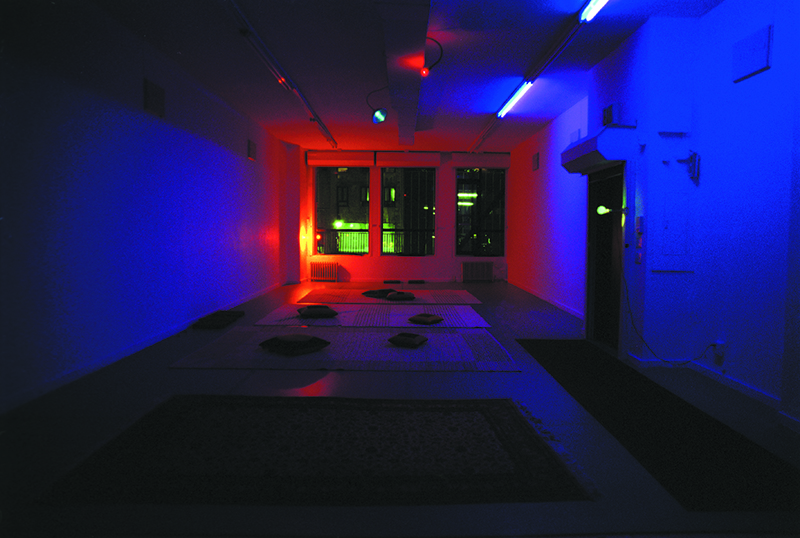
Obviously context, places are of importance. How so?
What are the differences on how you approach concerts, installations or composing at home?
Caring about, taking care of the potential listeners in a different way?
There’s a relationship between the structure of a composition and the place of presentation, both from an architectural and a social standpoint. The architectural aspects are often discussed – basically what’s the reverb time – but the social aspects less so. Are people sitting, lying down, or standing? Are people talking to each other? Where is their attention focused? What’s the relationship to the performers? I see a number of paradigmatic situations in this regard. The concert hall (proscenium theater) is the most obvious – a stage, the audience’s attention directed forward with little or no interaction with the performers, the rear essentially disregarded, one’s neighbor barely acknowledged. This is a physical position that I believe promotes very particular listening expectations, in terms of structure: a “narrative arc”, exemplified by the classical symphonic repertoire. It’s wrong to play the vast majority of chamber music in a (large) concert hall, this form of music is suited to private performances and small, intimate gatherings. If you look at any established style of music, it has a particular social setting, along with an appropriate architecture, in which it developed.
Some other paradigms would be the salon, the nightclub, the rock venue, outdoors, the black box and the loft. I call these paradigms because, once established as mental “spaces” of cognition, they can be replicated in other ways – the concert hall experience can be moved to the home in the form of a hi-fi system, but only under certain conditions: this worked well with the LP, which was the right length to sit through and required the act of placing the needle on and removing it from the record, a physical engagement with the delivery method. A hi-fi system from the 60s or 70s typically had a comfortable chair placed in front of the speakers, the listener would read the liner notes while listening, or pay rapt attention to the music. So, in one’s mind, you were in the concert hall.
Another paradigmatic space of listening is the recording studio. Though also usually a stereo setup, it’s characterized by the interactive nature of the process – in the sense of editing – as well as the visual component (the waveform and other visual aids, spectrographs and the like) that guides, so to speak, one’s ear. It’s also done by experts. I believe that a great deal of experimental music is composed for exactly this listening situation, in which the auditor assumes a certain control over the process, it’s not passive. So it would be interesting to try to replicate this as a way to listen for people outside the field, to enhance their ability to interact with the music. Glenn Gould wrote about this and, for example, CM von Hauswolff has a project (https://bilting.se/freq_spark/) where listeners can mix a sound online.
There’s a split in the modern music produced in the USA and in Europe after WW 2 and I attribute this to the spaces of presentation. In America, you had a loft scene and a connection to the art galleries and that’s where a lot of minimalism and other process-based music developed. In Europe you still had strong support from the traditional music community so avant-garde composers had more access to concert halls and orchestras. But there were also the radio stations: the studios and black box (rehearsal) spaces there that supported experimentation with multichannel sound systems. In America, in the concert halls, you had either the likes of Copland and Bernstein writing tonal music, or John Cage taking a kind of theatrical Dadaist approach.
As a composer you’ve got two options – you can compose for an existing space (this includes the social aspect) or you can create new spaces for listening that coordinate with your compositional practice. For example, I have a sound installation that’s designed to convert a living space into a permanent space for listening. I also use a portable multichannel sound system to turn apartments, libraries, art galleries and other spaces (including concert venues) into immersive sound environments. This is the way I prefer to present my modular sounds as well, in the context of an installation or multichannel presentation.
Of course the Dream House was a revelation and pointed the way to my gallery, Diapason. And institutions beginning with GRM have been innovating in this area for 75 years. But it’s now possible to do this quite cheaply and on one’s own, outside the state or academic institution. Given this possibility, I find it somewhat frustrating that the vast majority of music events are still staged performances.
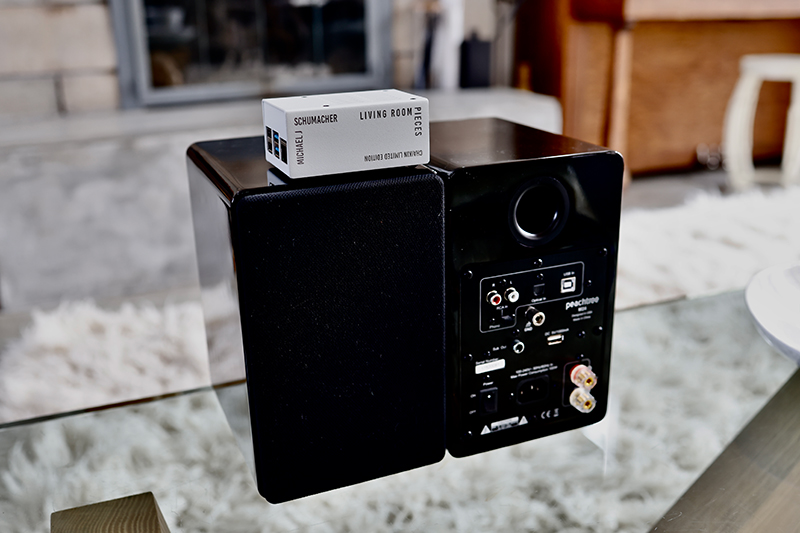
What have you been working on lately, and do you have any upcoming releases or performances?
I have a set of 12 Variations, a set of 12 Stills, a set of 12 “monthly Improvisations” and a number of other pieces, some multi-movement, others single, long pieces, about 2 dozen total, that I’ve been finishing up for both 8 channel and stereo. I’ve also got a sound installation for the home, Living Room Pieces (https://www.livingroompieces.com/), that uses a Raspberry Pi and 2 speakers, that I’ve been distributing privately and through ESS in Chicago (https://ess.org/news/2022/4/25/michael-j-schumacher-living-room-pieces) and will soon be selling a limited edition of through Chaikin Records. I’m also working with pianist Vicky Chow to record some older piano solo pieces.
Otherwise, I’ve been learning gen~, want to look into RNBO, and am really interested in collaborating with a computer scientist to create a virtual version of myself that will continue to spit out Michael Schumacher compositions after I’m dead.
You got interested and active in experimental music decades ago so how were you first acquainted to Modular Synthesis? When did that happen and what did you think of it at the time?
I started with synthesizers in 1976, when my parents bought me an Octave Cat.
My first modular experience was at Studio Pass, now Harvestworks, founded by Greg Kramer, where you could rent time to play on modular synths (I remember a Buchla) for $3/hour. At Indiana University I worked with a large Emu modular. These first experiences with synthesizers opened up a new kind of listening. You’re constructing a sound from the ground up, a static waveform is both an area of study and a stubborn mule – how to get the thing to do something (interesting)?
I took a class at Indiana and the teacher, C. Bryan Rulon, said something I always remember: he’d send the sound through a filter and change its frequency and, while performing an action would say, “you’ve got to turn the knob”, and he’d grimace, “with feeling.”
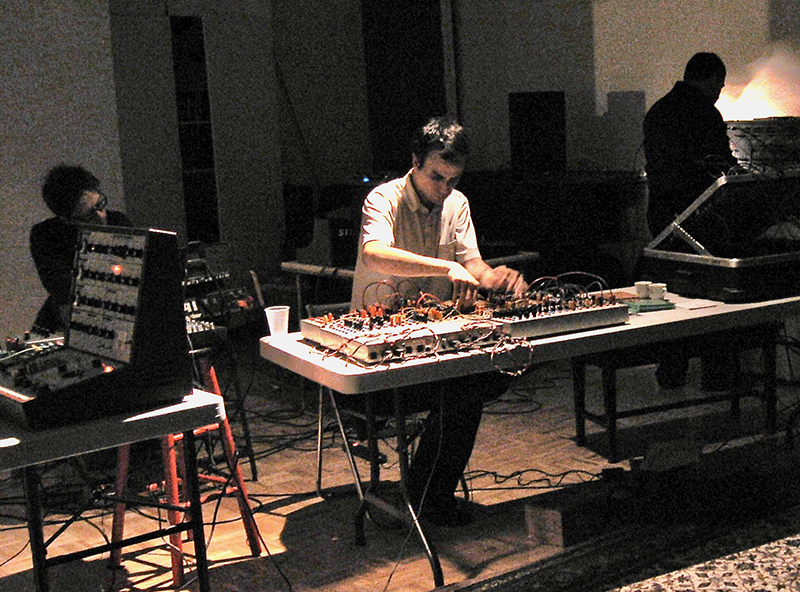
How does modular marry with your other « compositional tricks »?
Which other instruments do you like to pair it with ?
The synths become a sound source that’s recorded and used in compositions that begin as algorithms in Max. The algorithms modify the recordings in various ways – playback rate, plugin effects, granulation, looping, spatial parameters, etc. The basic approach is “contrapuntal”; an algorithm is essentially an independent “voice”, an automated player with unique characteristics. I combine these disparate players and listen to how they interact – does it produce something “greater than the sum of the parts”?
Other sounds include piano and other virtual instruments, field recordings, “found” sounds, recordings of other instruments played by friends.I also use Max to directly play the synthesizer, using the Expert Sleepers D-A converters.
When did you buy your first system?
In 2002. It’s a Serge, from the 70s, Dmitry Gelfand had a friend who was selling it. I was in discussion with Rex Probe but this came along and had a great set of modules so I grabbed it.
The Serge has 2 oscillators, a New Timbral oscillator, 3 filters, the resonant EQ, slope generators, random and step generators, smooth function generator, frequency shifter, phaser, ring modulator, dual and active processors, wave multipliers, ADSR, /N comp, 4 channel mixer, preamp.
How long did it take for you to become accustomed to patching your own synthesizer together out of its component parts?
A patch for me is putting the oscillator into the amplifier, so not very long. That’s still how I start, and my process is basically to start a new patch whenever I decide to “harvest” (Ed Tomney’s wonderful term) some sounds. I love the sound of an electronic oscillator. And it’s interesting that when you start at a certain frequency, it will color your perception of how the patch develops, what sort of modulation works, what kind of filter to use, and when it comes to playing a Serge instrument I like the system and how it works together.
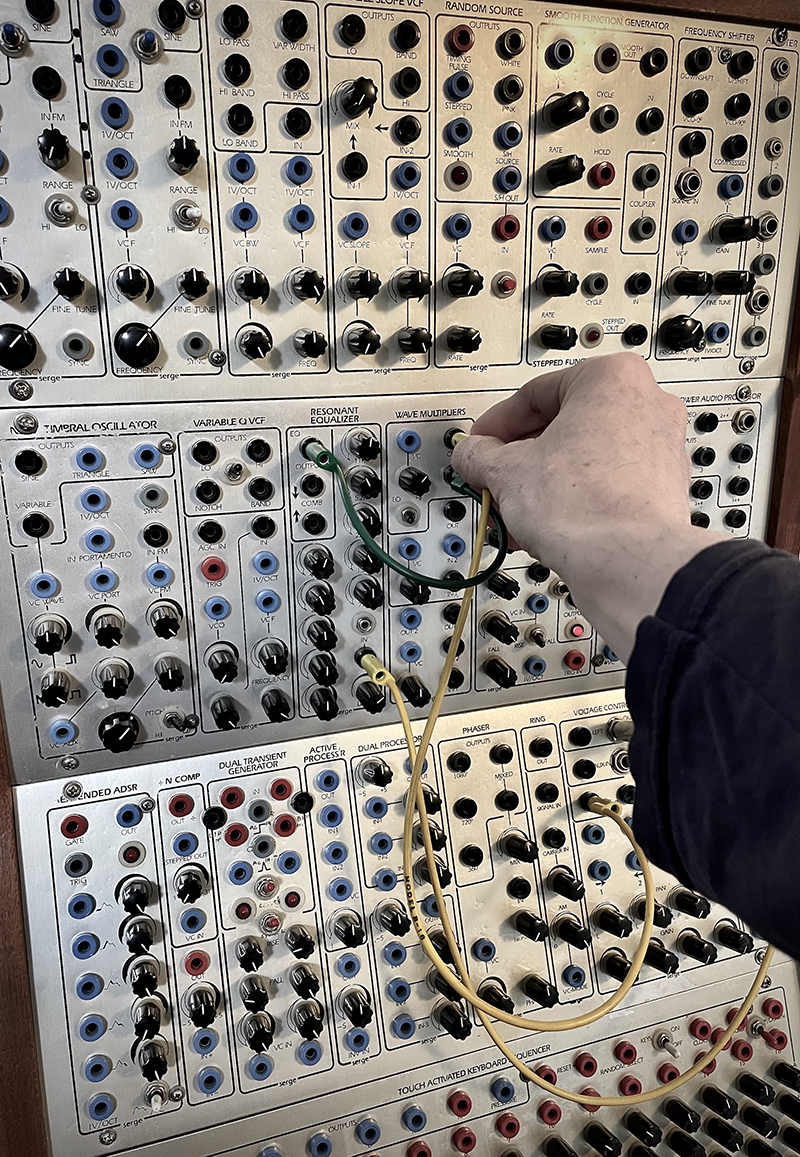
What was the effect of that discovery on your compositional process?
This was quite early in my process (1982). The first piece I made with the Emu at IU was called “Nature & Static”; it had two parts (obviously): the 1st was a single chord articulated by 6 tone generators (specific Emu patches) that each played a note of the chord in a permutated ordering. So it was like a soft, pulsing chord, almost a drone. The second part was a loop that gradually increased in loudness and power, reacting with an Eventide H910 that did this great thing to it, so that when it hit this peak, it sort of exploded into an array of pitches. So the “irony” of the piece was that the first part, which was kind of a drone and didn’t change much, was “nature”, and the second part, which was a loop, and somewhat machine-like and artificial and processed, but that also grew and increased and exploded, was “static”, i.e. noise, man-made, etc.
In any case, I decided to present the piece, as part of my senior recital, in complete darkness. My teacher, Bernhard Heiden (actually he was my earlier teacher there, by 1982 I was studying with John Eaton, who you should do an episode on, btw!) had said, “the only thing I like about electronic music “concerts” is when something goes wrong”. So it made me realize that people sitting in a concert hall, staring at a couple of speakers, was problematic, that you had to create a space for listening that matched the structure and form of presentation of the music (at that time I had no knowledge of GRM and acousmatic music, etc.). This realization led steadily to my work with multichannel sound systems and the establishment of Diapason, my sound gallery.
On your existence?
It led it to a life on the fringes, haha. It continues to be clear that “serious” or modern classical, or whatever you want to call it, will remain a performance dominated art form – even if these end up as recordings.
The notion of the solitary composer working in the studio, like a painter with sound, remains an anomaly.
In fact, music as a collaborative or even communal undertaking, is the stronger trend.
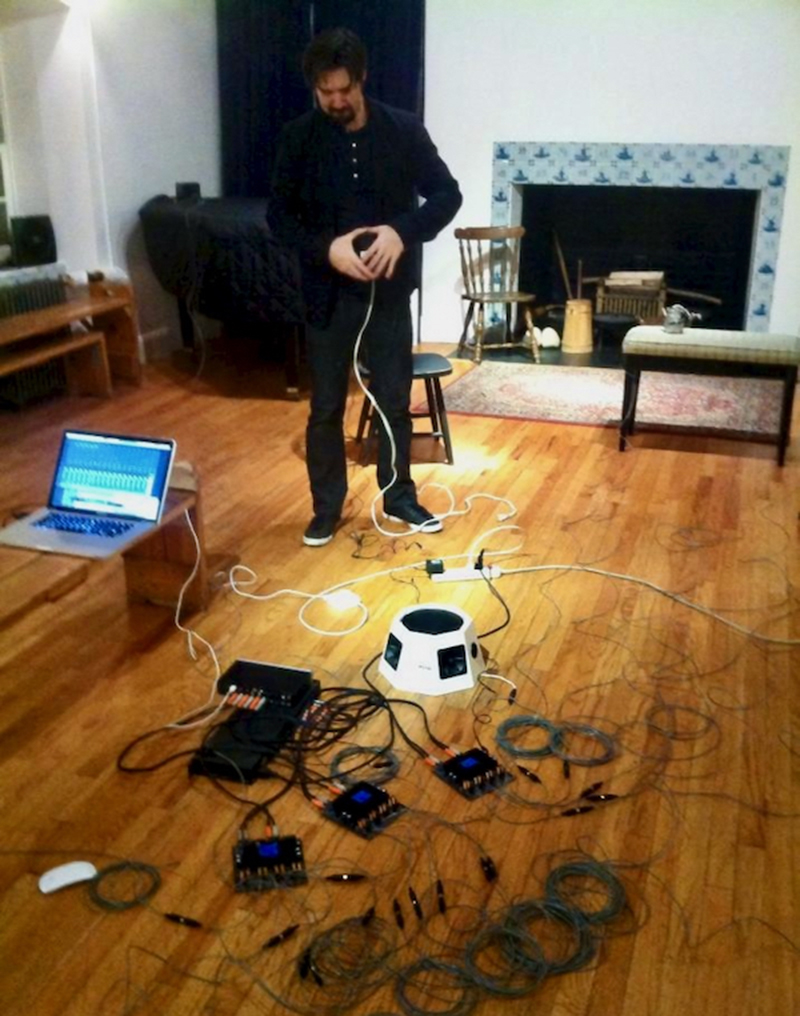
Quite often modularists are in need for more, their hunger for new modules is never satisfied? How do you explain that?
1. The way the music instrument (in the most general sense) industry is set up (see “Any Sound You Can Imagine: Making Music / Consuming Technology” by Paul Théberge, or “The Cultural Industries” by David Hesmondhalgh.
2. Gear fetishism.
3. The fact that one can understand a synthesizer module as a node of creativity, like a musical motif, that will have a certain life span, generating ideas specific to it for a time, and then expiring, losing its creative function.
Instrument building may actually be quite compositional, defining your sonic palette, each new module enriching your vocabulary. Would you say that their choice and the way you build your systems can be an integral part of your compositional process?
I’ve only built one system “from the ground up”, which is my euro-rack system, which began with almost all Verbos modules. I liked his approach, it fit my idea of what was important. I don’t really equate synthesis with my compositional process, it is a means to create one of the resources that I will use in composing. So I built the system based on my preference for synthesizing sounds, but this is a separate activity, for me, than composition.
I also, for a while in the 80s, used MIDI system exclusive to control parameters on a digital synthesizer, the TX-802, which turned it into a kind of automated modular system.
I own or have owned a number of synthesizers – the Serge, a Steiner Parker, a Synthi, ARP 2600, an Xpander, Minimoog, the euro-rack, also effects pedals. There’s no question that the particular sound and architecture can suggest compositional approaches, just as any technology does. I’m a keyboardist, so if I use that skill while working with the synth, the ideas will go in that direction.There’s a philosophy where the patch is the piece, even to the point of evolving over time. This is a kind of holy grail for some, I think; I know it was discussed when I was at IU. It’s a beautiful idea and, in a way, it’s how I approach composing with Max, which is why I preferred the computer to tape composition back when both were a viable choice. Even though I write what I’d call counterpoint, the structure of a composition is something I conceive of as a totality, not one track or voice at a time. So even though I’m not building a synthesizer as part of the compositional process, I think of a Max patch in the idealized way described above, as an evolving totality that, once unleashed, will lead to unexpected combinations of elements.
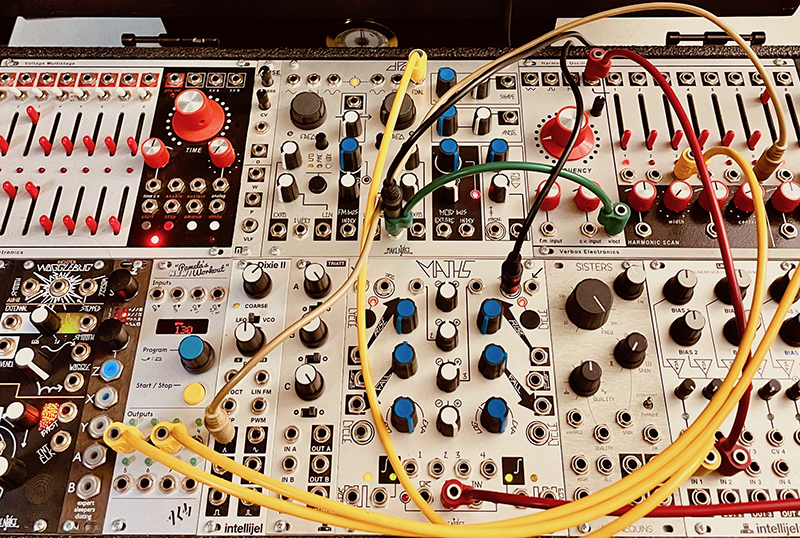
How has your system been evolving?
Since beginning with the Verbos (and the ES-3), I’ve added some other makers, including Intellijel and Make-Noise. I found the Verbos dual oscillator to be unstable, unreliable. In general, his modules are noisy and it seems of cheap build quality, though maybe this is a design choice in terms of the sound he wants.
In a sense, my system now consists of the Serge, a Dominion I, a Synthacon, a Subphatty, a GR-1, the euro-rack, and various soft-synths. I use these all together, each for its own distinctive qualities, rather than building a single, large mudular system.
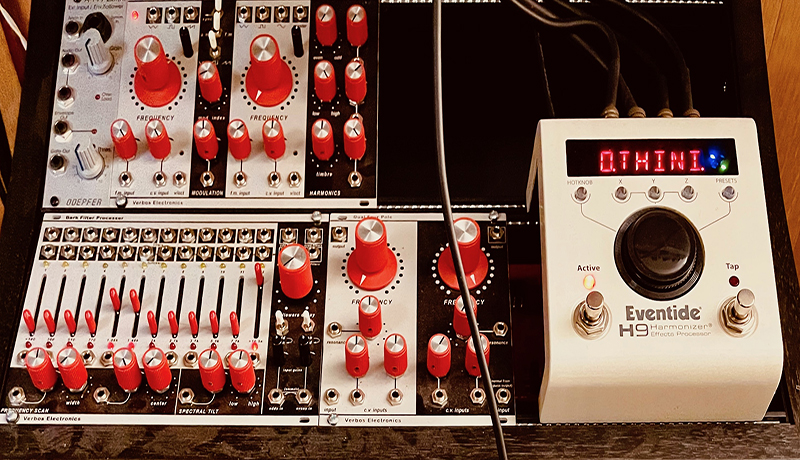
How do you compose? Would you please describe the system you used to create the music for us? How did you organize and select sounds? Chose players?
I compose using algorithms in Max. The original metaphor for my system involves a listener, sitting in a room, surrounded by windows that open onto specific “sonic activities” – ongoing processes. Timing algorithms open and close the windows, allowing the listener to hear the various sounds in various combinations, so that not only will they be meaningful as ongoing processes, but they will also inform and contextualize each other. The composition is a study in these relationships. With this as a starting point, I’ve developed an increasingly complex system for automating various aspects of the compositional process, the latest being those involved with spatialization. The system is based on six prime numbers – 17, 23, 29, 31, 37 and 43, symmetrical around 30 – which form the basis for all timing decisions. At the level of the articulated note, the six primes are milliseconds; at the structural level, by multiplying each by 10,000, they become, for example 170 seconds, or 2 minutes and 50 seconds. This unity imbues the music with a sense of compositional intent, even though most of the decisions are, to a certain extent, random.
For example, the piece “Noema” includes Serge modular, Steiner Parker Synthacon and Eurorack w/Verbos, Makenoise, etc. “Noema” is part of a series of pieces that use looped short samples – the samples and timings – both of the loop durations, which vary with each iteration, and how long a particular sample will play for – are determined by algorithms. These pieces can be presented as installations or as fixed pieces. In this case, I added variations to the samples as they repeat. There are 6 “voices”, call them A-F, each of which plays a sound chosen from a library of 3107 short sample, ranging in length from about 30-10000 milliseconds. If voice “A” chooses sample #1792, it will reiterate that sound in cycles determined by the primes, multiplying these by, say, 300, to get time interval choices of 5.1, 6.9, 8.7, 9.3, 11.1 and 12.9 seconds. Voice A will play this chosen sound for a duration also determined by choosing one of the six primes, but multiplied by 5000, to get a structural duration of between 85 and 215 seconds, at which point it will choose a new sound.
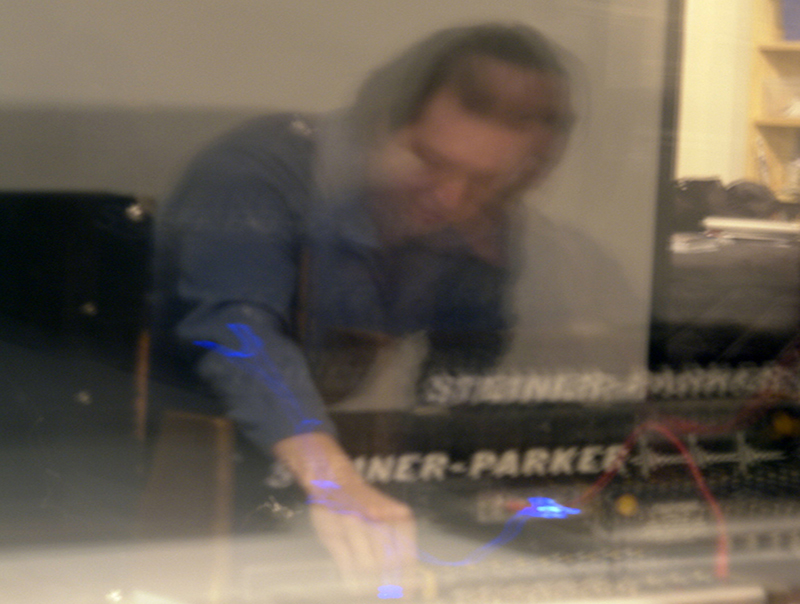
“Variations”, nos. 2 + 10 and 12 – mixed media including Serge modular, Steiner Parker Synthacon and Eurorack w/Verbos, Makenoise, etc.
These are from a set of 12 Variations, the second set of twelve I’ve composed. The idea behind Variations is to vary, not the rhythms and pitches of the musical motifs, but the spatial and signal processing aspects. For example, at the beginning of Var. 2, there’s a short phrase that repeats; the actual basis recording is sent through a variety of filters and other processes, as well as being “re-spatialized” (the original uses an 8 channel sound system).
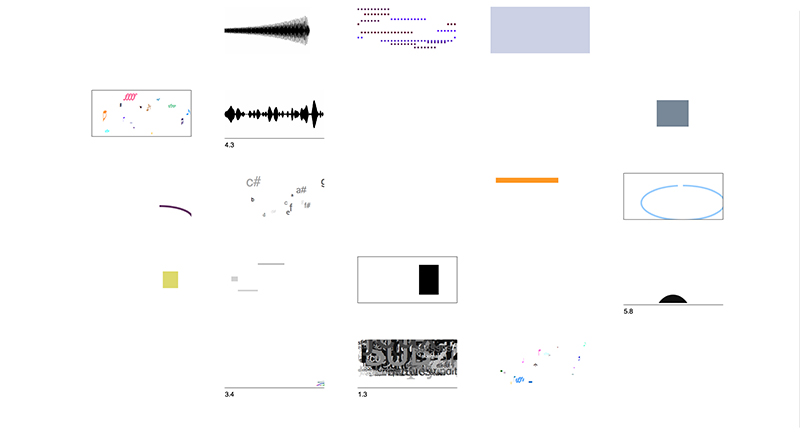
« Duet w/ Keith Richards » & « Improvisation » : mixed media Eurorack w/Verbos, Makenoise, and recordings…
These are two improvisations using a eurorack modular which I recorded, edited and added some recordings to, the first, an interview with Keith Richards (highly distorted), the second, a band playing some Swiss folk music.
« Sound Pets » and « L’ Âge d’Or » are DINMachine songs: Eurorack synth, Moog Subphatty (bass) and drums which are almost entirely modular synth pieces.
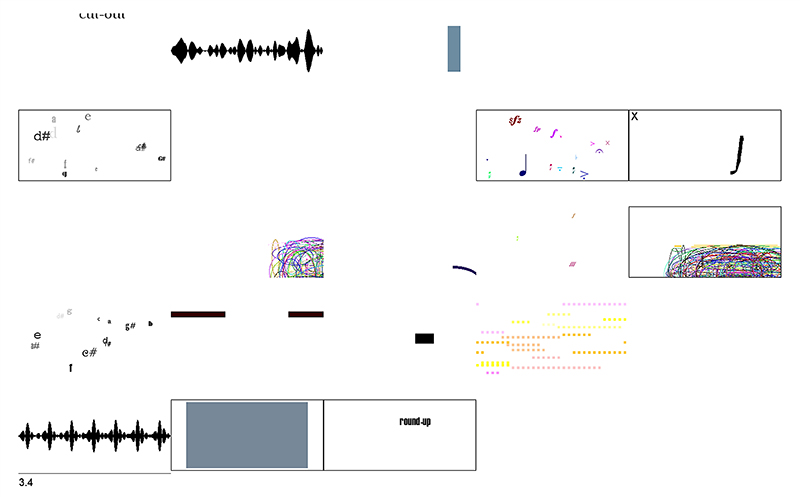
What do you think that can only be achieved by modular synthesis that other forms of electronic music cannot or makes harder to do?
First of all, I would restrict this question to classical modular synthesis and exclude from it modules that are, in fact, small computers, that are multi-purpose. For me, the combination of exposing the elements of sound and the interactive possibilities makes modular synthesis unique, impossible to do on any other system.
The existence of all the historical instruments, each with its own sound, along with the effects of aging and design philosophy, as well as all the new makers, is also special to modular synthesis.
MIDI controllers are too generic; modular systems have controls that are, again, specific to the design philosophy of the maker. The feel of knobs vs. sliders, touch pads, keyboards, their ranges, the slew, having everything on the surface. I’m glad to have been able to experience and benefit from this resurgence in interest in modular synthesis.
What would be the system you are dreaming of?
A large Serge that includes a technician with infinite knowledge of the system.
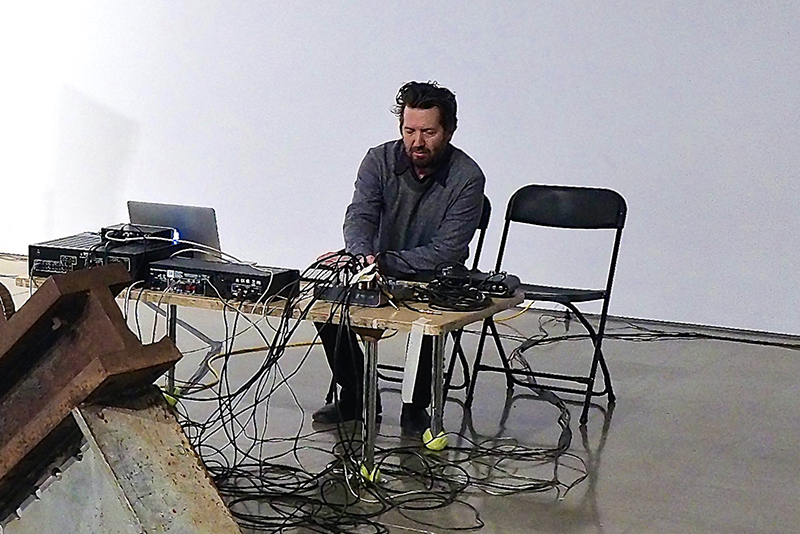
Are you feeling close to some other contemporary Modularists?
Ed Tomney has a very special approach – to everything he does but also to modular synthesis. James Fei is a total expert and brings tons of musicality to his playing. Jim O’Rourke is one of my favorite composers. Thomas Ankersmit is fabulous. Scanner is awesome. Other people I really like are Marcia Bassett, David Galbraith, Robert Aiki Aubrey Lowe, Svetlana Maras, Emma Souharce, Sergei Tcherepnin and Keith Fullerton Whitman.
I also really like your work Philippe!
Which pioneers in Modularism influenced you and why?
Tomita, Kraftwerk and Morton Subotnick were the big ones when I was young.
I don’t know why, just found their work fascinating and beautiful. I think the instruments themselves had an appeal – not necessarily modular but the Synthacon, Odyssey, 2600, the ones I’d see in the candy I mean music stores.
Any advice you could share for those willing to start or develop their “Modulisme” ?
Embrace a hybrid approach.
Don’t fetishize gear; old or new, it’s all good.
When working, step away from the interaction with the equipment and think. I like what Autechre do, according to an interview I read: any new piece of gear they get, they’ll use it, by itself, to compose a piece. No matter its limitations they’ll figure out how to make it do what they have in mind.
